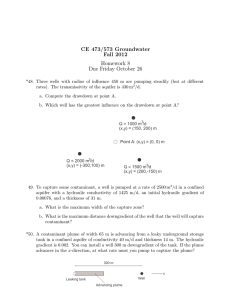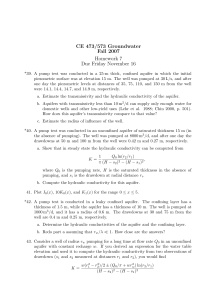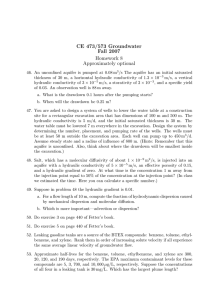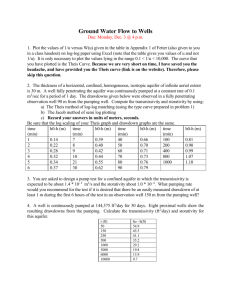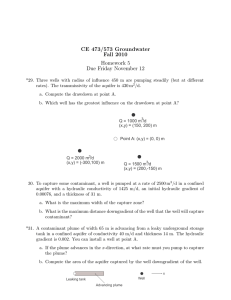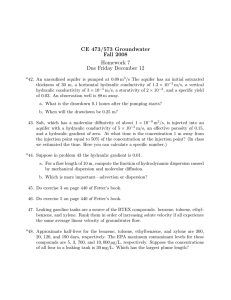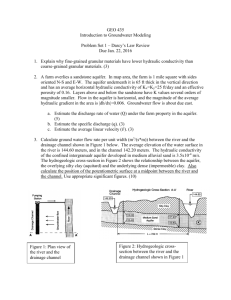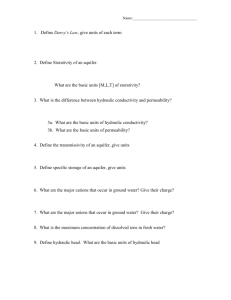CE 473/573 Groundwater Fall 2011 Homework 5 Due Wednesday November 16
advertisement
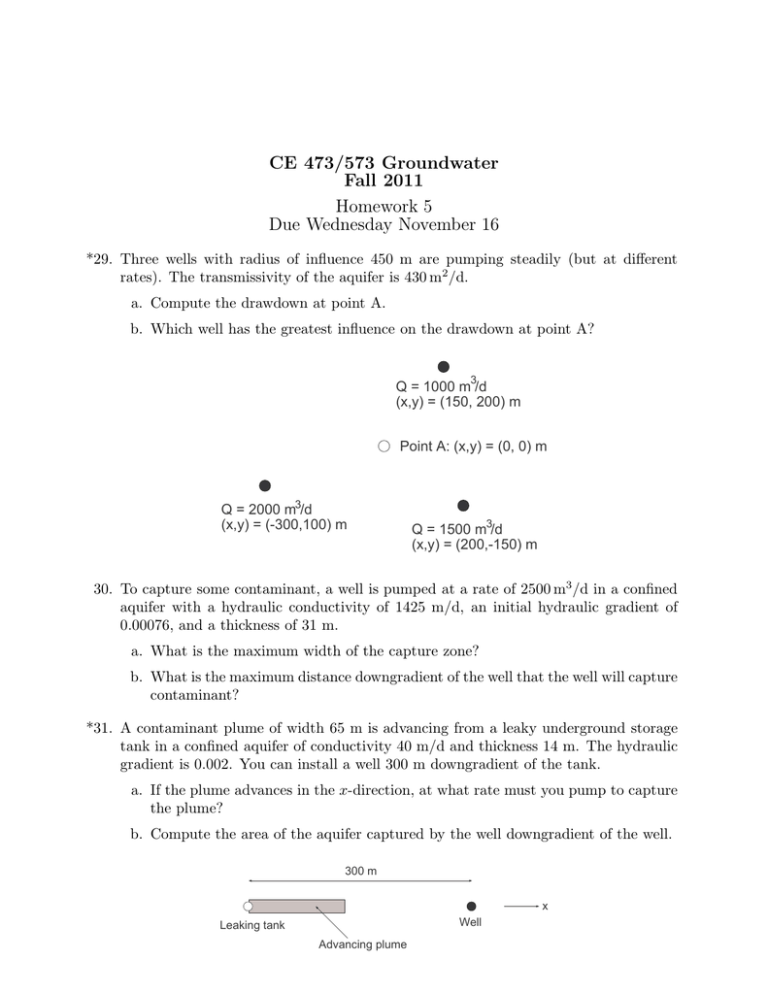
CE 473/573 Groundwater Fall 2011 Homework 5 Due Wednesday November 16 *29. Three wells with radius of influence 450 m are pumping steadily (but at different rates). The transmissivity of the aquifer is 430 m2 /d. a. Compute the drawdown at point A. b. Which well has the greatest influence on the drawdown at point A? 3 Q = 1000 m /d (x,y) = (150, 200) m Point A: (x,y) = (0, 0) m Q = 2000 m3/d (x,y) = (-300,100) m Q = 1500 m3/d (x,y) = (200,-150) m 30. To capture some contaminant, a well is pumped at a rate of 2500 m3 /d in a confined aquifer with a hydraulic conductivity of 1425 m/d, an initial hydraulic gradient of 0.00076, and a thickness of 31 m. a. What is the maximum width of the capture zone? b. What is the maximum distance downgradient of the well that the well will capture contaminant? *31. A contaminant plume of width 65 m is advancing from a leaky underground storage tank in a confined aquifer of conductivity 40 m/d and thickness 14 m. The hydraulic gradient is 0.002. You can install a well 300 m downgradient of the tank. a. If the plume advances in the x-direction, at what rate must you pump to capture the plume? b. Compute the area of the aquifer captured by the well downgradient of the well. 300 m x Well Leaking tank Advancing plume *32. A well in a confined aquifer of transmissivity 210 m2 /d sits near a no-flow boundary. The well pumps steadily at 300 m3 /d, and its radius of influence is 1000 m. The coordinates of several points are shown in meters. The boundary continues beyond the points shown. a. What is the drawdown at point A? b. If the boundary were not there, what would the drawdown at point A be? c. Explain the difference between the drawdowns in parts a and b. (-550, 900) No -flo w bo un Well (0,0) da ry Pt. A (350,100) (1050, -50) *33. You are asked to design a system of wells to lower the water table at a construction site for a rectangular excavation area that has dimensions of 100 m and 500 m. The hydraulic conductivity is 5 m/d, and the initial saturated thickness is 30 m. The water table must be lowered 7 m everywhere in the excavation. Design the system by determining the number, placement, and pumping rate of the wells. The wells must be at least 50 m outside the excavation area. Each well can pump up to 450 m3 /d. Assume steady state and a radius of influence of 800 m. (Hints: Remember that this aquifer is unconfined. Also, think about where the drawdown will be smallest inside the excavation.) *34. A pump test is conducted in a leaky confined aquifer. The confining layer has a thickness of 1.5 m, while the aquifer has a thickness of 10 m. The well is pumped at 1000 m3 /d, and it has a radius of 0.6 m. The drawdowns at 30 and 75 m from the well are 0.4 m and 0.25 m, respectively. Determine the hydraulic conductivities of the aquifer and the confining layer. 35. A well is placed in a confined aquifer with thickness 8 m, storativity 3 × 10−5 , and hydraulic conductivity 4 × 10−4 m/s. The well starts pumping at 500 gpm. a. Plot the drawdown as a function of time (for one day) at an observation well 250 m away. b. Plot the drawdown as a function of distance from the well 6 hours after the well starts pumping. *36. A confined aquifer of thickness 30 m is pumped at a rate of 150 L/s from a well of radius 0.3 m. The drawdowns measured 100 m away at 100, 1000, 104 , 105 , and 2×105 seconds are 4.02, 123.6, 366.4, 627.6, and 705 cm, respectively. a. Determine the aquifer’s storativity, transmissivity, and hydraulic conductivity. b. Use the Jacob approximation to determine the storativity, transmissivity, and hydraulic conductivity of the aquifer. Compare to the answers in part a. *37. An unconfined aquifer is pumped at 0.08 m3 /s The aquifer has an initial saturated thickness of 30 m, a horizontal hydraulic conductivity of 1.3 × 10−3 m/s, a vertical hydraulic conductivity of 3 × 10−5 m/s, a storativity of 2 × 10−3 , and a specific yield of 0.03. An observation well is 88 m away. a. What is the drawdown 0.1 hours after the pumping starts? b. When will the drawdown be 0.25 m? *38. Consider the effect of Γ = r 2 Kv /b2 Kh on the drawdown caused by unsteady flow to a well in an unconfined aquifer. a. As Γ increases, does the drawdown become larger or smaller? Explain your answer. b. For which value of Γ does the behavior approach that for a confined aquifer? Explain your answer.
